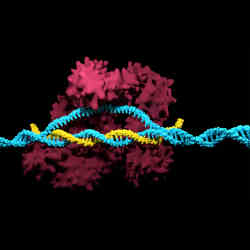
Genetic engineering, once the stuff of science fiction novels, has emerged as a powerful scientific tool. The ability to program and reprogram genes now touches fields as diverse as agriculture and medicine. The driving force largely responsible for this remarkable revolution? CRISPR, a toolkit that allows researchers to edit, manipulate, and rearrange genes in pursuit of new medicines, more robust crops, and insects that no longer carry diseases.
The path to progress is also paved with concerns, however. "While biologists are clearly excited by the potential benefits of these technologies, there is also a recognition that the promise is most likely to be realized when the technology is well understood, controllable in the actual situations where it would be employed, and able to be inactivated when necessary," says John Godwin, professor in the Department of Biological Sciences at North Carolina State University.
In other words, CRISPR and other gene editing toolkits represent a level of risk. A gene might go haywire and cause fruit to rot faster, or rogue scientists could engineer soldiers or athletes with superhuman strength—or new weapons of mass destruction (WMDs). "There could be both unintended and intended consequences," observes Renee Wegrzyn, Safe Genes program manager in the Biological Technologies Office at the U.S. Defense Advanced Research Projects Agency (DARPA).
The upshot? "With the surge in CRISPR-based technologies, there is an acute demand for developing 'off' controls that can achieve precise and temporal control over both wild-type and engineered CRISPR-associated proteins," says Amit Choudhary, assistant professor of medicine at Harvard Medical School and a member of the Broad Institute, which supports research and ethical standards across the Massachusetts Institute of Technology, Harvard University, and Harvard-affiliated hospitals.
Coding Controls
CRISPR, which exploits a quirk in the immune system of bacteria to create editing tools for genes, has already made its presence felt. Researchers have found ways to reduce genetic deafness in mice (which could one day translate into a cure for human deafness) and gained insights into possible cures for genetic diseases such as muscular dystrophy. The technology could lead to more desirable traits in plants, animals, and humans.
However, CRISPR could also make it possible to resurrect extinct species, from carrier pigeons to dinosaurs. It could usher in designer humans and pets and introduce cells that inadvertently trigger cancer or abnormalities. While the potential payoff from the technology is high, ethical concerns and potential risks are great. For instance, In November 2018, a Chinese scientist, He Jiankui, was widely condemned for using CRISPR to produce a pair of babies that were HIV-resistant.
Enter the idea that CRISPR needs a control mechanism or kill-switch. In 2016, James Clapper, then U.S. director of national intelligence, warned that gene editing represented a WMD threat. The same year, DARPA launched the Safe Genes program to enable the safe pursuit of gene editing technologies, while mitigating the risk for intentional and unintentional misuse.
Since then, DARPA has worked with the scientific community to approach the technology in a responsible way—and to develop mechanisms to manage it. "It's critical to have the ability to control, counter, and reverse the effects of genome editing built in at the inception of these technologies," Wegrzyn explains. This includes the ability to return a biological system to its baseline genetic state.
Building a Better Toolkit
DARPA and outside groups of scientists are taking aim at the challenge on several fronts. The Safe Genes program is focused on areas as diverse as off-target effects, genetic variability, algorithms and, ultimately, how to design better frameworks and guides for editing RNA and DNA. "We are not trying to predict how gene editing could be used or misused; if you design solutions for a specific use-case, you put yourself at a disadvantage. We want to create a toolkit that is useful for almost any situation," Wegrzyn says.
The initiative has been embraced by researchers.
At the Broad Institute, Choudhary and fellow scientists are working to develop ways to switch on and off genome editing in bacteria, insects, and mammals. This includes a focus on chemicals that could inhibit or block genome editors.
At Harvard Medical School, professor George Church is exploring ways to detect, prevent and reverse mutations caused by exposure to radiation.
At the University of California, Berkeley, Jenifer Doudna, a co-creator of CRISPR, is studying proteins that could inhibit undesirable genome-editing activity and thwart bioterrorism threats.
North Carolina State's Godwin, who is part of a project using CRISPR to develop tools to manage invasive species that threaten biodiversity and human food security, believes researchers will ultimately develop a number of techniques to inhibit, reverse and reset gene editing. "CRISPR-based systems are likely to become steadily more 'programmable' and predictable over the next few years," he says.
Adds Wegrzyn, "Societal impact cannot be an afterthought; it must instead be a foundation on which the science advances."
Samuel Greengard is an author and journalist based in West Linn, OR, USA.



Join the Discussion (0)
Become a Member or Sign In to Post a Comment